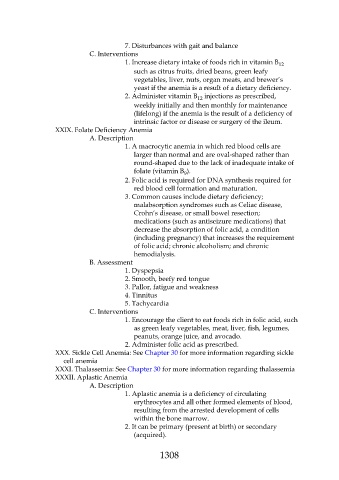Page 1308 - Saunders Comprehensive Review For NCLEX-RN
P. 1308
7. Disturbances with gait and balance
C. Interventions
1. Increase dietary intake of foods rich in vitamin B 12
such as citrus fruits, dried beans, green leafy
vegetables, liver, nuts, organ meats, and brewer’s
yeast if the anemia is a result of a dietary deficiency.
2. Administer vitamin B injections as prescribed,
12
weekly initially and then monthly for maintenance
(lifelong) if the anemia is the result of a deficiency of
intrinsic factor or disease or surgery of the ileum.
XXIX. Folate Deficiency Anemia
A. Description
1. A macrocytic anemia in which red blood cells are
larger than normal and are oval-shaped rather than
round-shaped due to the lack of inadequate intake of
folate (vitamin B ).
9
2. Folic acid is required for DNA synthesis required for
red blood cell formation and maturation.
3. Common causes include dietary deficiency;
malabsorption syndromes such as Celiac disease,
Crohn’s disease, or small bowel resection;
medications (such as antiseizure medications) that
decrease the absorption of folic acid, a condition
(including pregnancy) that increases the requirement
of folic acid; chronic alcoholism; and chronic
hemodialysis.
B. Assessment
1. Dyspepsia
2. Smooth, beefy red tongue
3. Pallor, fatigue and weakness
4. Tinnitus
5. Tachycardia
C. Interventions
1. Encourage the client to eat foods rich in folic acid, such
as green leafy vegetables, meat, liver, fish, legumes,
peanuts, orange juice, and avocado.
2. Administer folic acid as prescribed.
XXX. Sickle Cell Anemia: See Chapter 30 for more information regarding sickle
cell anemia
XXXI. Thalassemia: See Chapter 30 for more information regarding thalassemia
XXXII. Aplastic Anemia
A. Description
1. Aplastic anemia is a deficiency of circulating
erythrocytes and all other formed elements of blood,
resulting from the arrested development of cells
within the bone marrow.
2. It can be primary (present at birth) or secondary
(acquired).
1308

